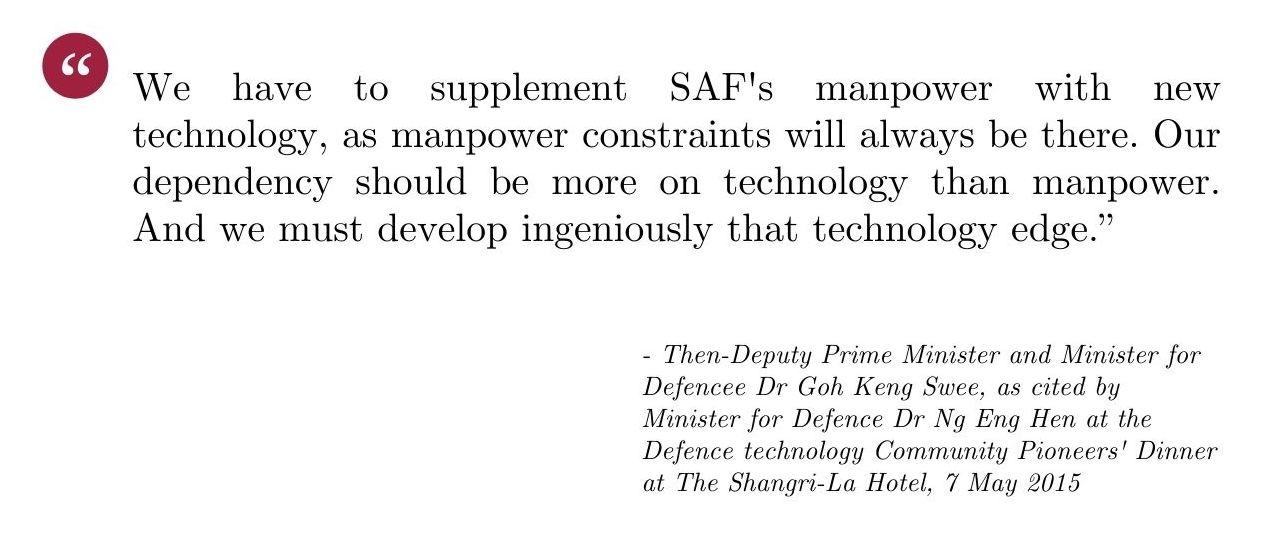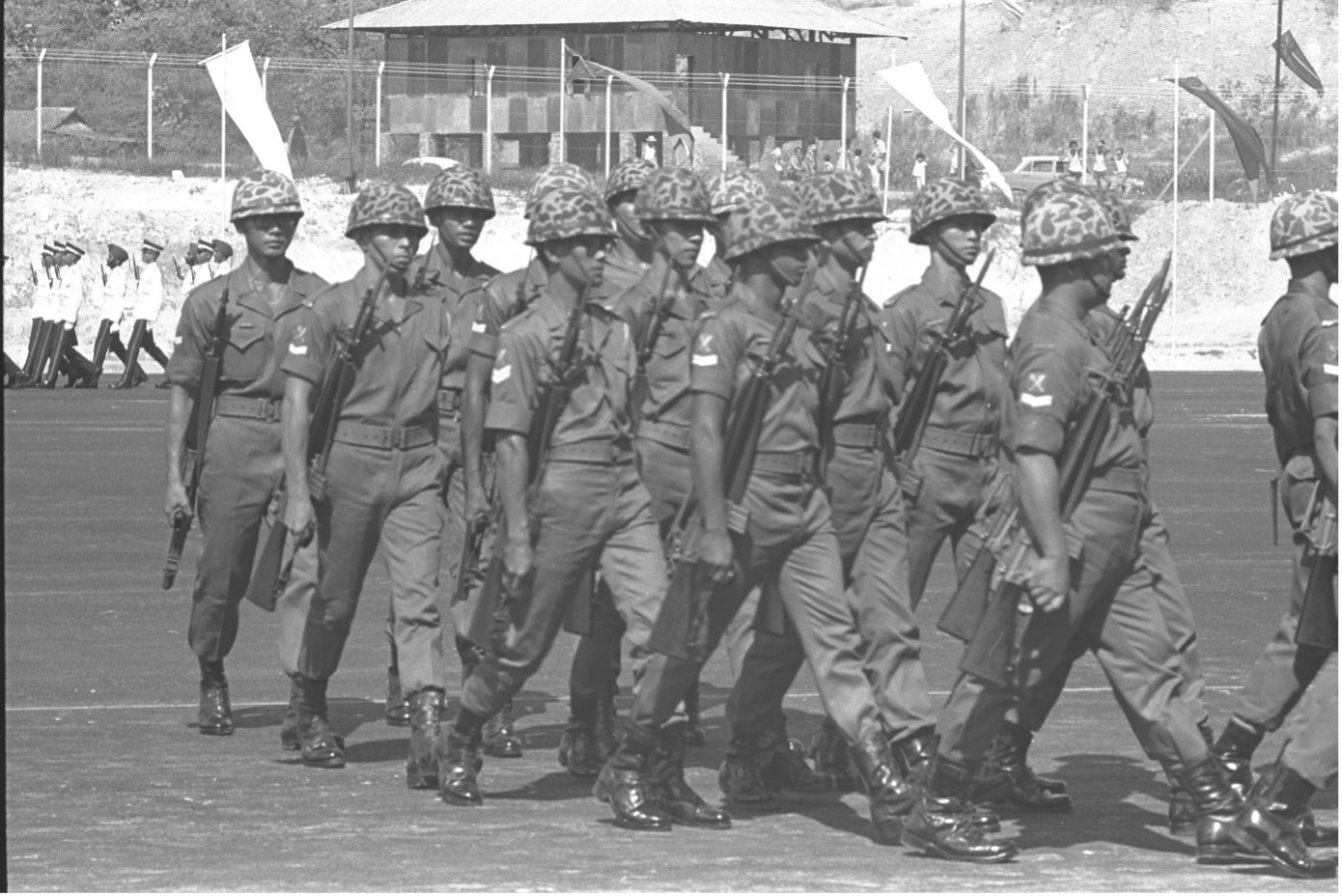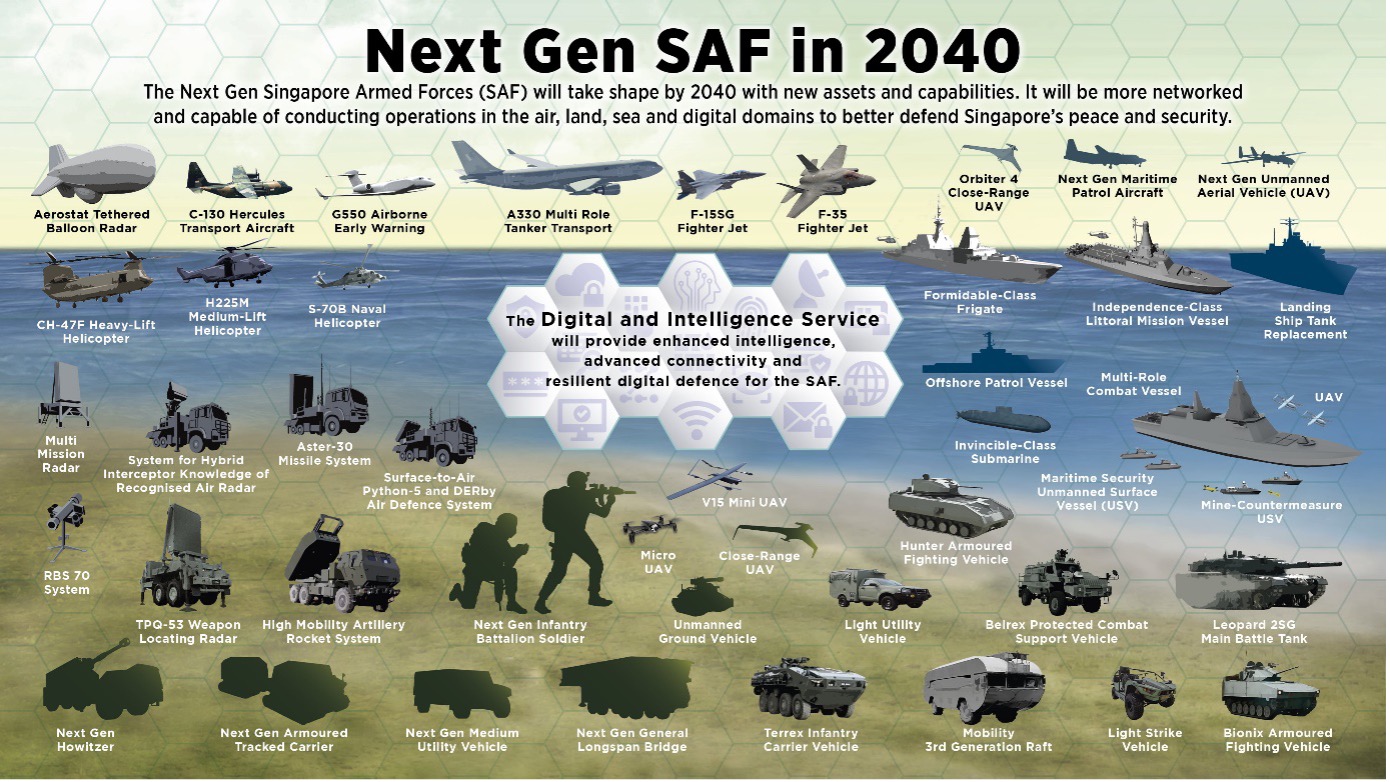Building a Strong Defence
Building a Strong Defence
Singapore’s vulnerabilities and the constantly shifting security landscape demand that we frequently fine-tune how we best defend our interests.
Our defence policy is based on the twin pillars of deterrence and diplomacy. This allows Singapore to enjoy security, peace and stability while protecting our sovereignty, territorial integrity and way of life. A strong defence also allows Singapore to act in our national interests without being swayed by external pressures.
The First Pillar: Diplomacy
Singapore places great importance on the development of defence relations with other countries. Our defence diplomacy efforts enable us to improve mutual trust and understanding between Singapore and other countries, meet the Singapore Armed Forces (SAF)’s training and defence technology needs, and facilitate multilateral efforts to strengthen regional security and stability.
Singapore has also been a strong advocate of upholding an open and inclusive regional security architecture that is underpinned by international law. Singapore supports multilateral platforms and international organisations such as the Association of Southeast Asian Nations (ASEAN), ASEAN Defence Ministers Meeting (ADMM), and the United Nations (UN). These organisations set guidelines and rules on how nations should interact with each other, and create a fair and transparent playing field for countries of different sizes to engage each other even in times of disagreement and conflict. These organisations also provide platforms for countries to engage in constructive dialogue and cooperation to tackle transnational issues.
The ASEAN Defence Ministers’ Meeting (ADMM), established in 2006, is the highest-level defence consultative and cooperative mechanism in ASEAN. It aims to promote mutual trust and confidence through dialogue and practical cooperation. In 2010, the ADMM-Plus was established. The ADMM-Plus is the de facto regional security platform for ASEAN and eight of its Dialogue Partners (Australia, China, India, Japan, New Zealand, Russia, South Korea, and the United States, collectively referred to as the “Plus Countries”) to strengthen security and defence cooperation for peace, stability and development through the ADMM-Plus Meetings and its Experts Working Groups.
 Minister for Defence Dr Ng Eng Hen (centre) at the ADMM Retreat held virtually on 10 November 2021. Image: MINDEF.
Minister for Defence Dr Ng Eng Hen (centre) at the ADMM Retreat held virtually on 10 November 2021. Image: MINDEF.
Another example is the Shangri-La Dialogue (SLD), an annual dialogue that brings together defence ministers and military chiefs from around the world to exchange perspectives on the region’s most pressing security challenges. It is organised by the International Institute for Strategic Studies (IISS), with support from the Singapore government. The dialogue gets its name from the location where it is held – the Shangri-La Hotel in Singapore. The event is a platform that allows countries to strengthen defence relations, build understanding and foster practical cooperation with one other.
 Prime Minister Mr Lee Hsien Loong delivering the keynote address at the SLD on 31 May 2019. Image: MINDEF.
Prime Minister Mr Lee Hsien Loong delivering the keynote address at the SLD on 31 May 2019. Image: MINDEF.
As a responsible member of the international and regional community, Singapore also contributes to international security efforts.
Maritime Security Efforts
The Straits of Malacca and Singapore (SOMS) are critical and strategic waterways as about half of the global yearly seaborne trade and 70% of Asia’s oil imports pass through the SOMS. To deal with rising piracy rates in the SOMS and ensure its security, the Malacca Straits Patrol initiative was launched in 2004, and includes Indonesia, Malaysia, Thailand and Singapore. The measures include the Malacca Straits Sea Patrol, the “Eyes-in-the-Sky” Combined Maritime Air Patrols and the Intelligence Exchange Group. Singapore works together with the other member countries to conduct regular patrols and exchange information to ensure the safety and security of the waterways. The cooperation was a success. In 2006, the Lloyd’s Joint War Risk Committee decided to drop the classification of the Malacca Strait as “a war-risk area”.
Internationally, Singapore plays a part in ensuring the security of global waterways. In 2018, Singapore successfully completed its fifth command of the Combined Task Force (CTF) 151, as part of the international counter-piracy efforts in the Gulf of Aden (GoA). The 2018 deployment was also the SAF’s last and 11th deployment to the Gulf of Aden. Since 2009, Singapore has deployed five ships and one maritime patrol aircraft, five SAF command teams, five task groups and one air detachment to support counter-piracy operations in the Gulf. These deployments involved more than 1,400 sailors, soldiers and airmen and women.
Humanitarian Assistance and Disaster Relief (HADR) Missions
Singapore rendered assistance to Aceh in the aftermath of the 2004 Boxing Day tsunami. In the largest SAF overseas operation conducted so far, more than 1,500 SAF personnel and three Endurance-class landing ships tank (LSTs) were deployed as part of the HADR efforts. In 2021, the RSAF deployed an A330 Multi-Role Tanker Transport (A330 MRTT) aircraft to Qatar to assist in the evacuation of Afghanistan evacuees to Germany.
Second Pillar – Deterrence
The second pillar of Singapore’s defence is deterrence, which is contingent on a strong and capable SAF and a resilient and committed populace, through the institutions of National Service (NS) and Total Defence (TD).
Building robust deterrence means steadily investing in capabilities to ensure that our armed forces’ hardware and technology stay up to date. Furthermore, it means developing our people and equipping them with the necessary knowledge and expertise to ward off potential aggressors.
These efforts require significant investments in financial and manpower resources. Investments are made in human capital, infrastructure, technology, as well as in new capabilities, and research and development endeavours. The SAF uses technology as a “force multiplier”, developing defence science to augment the SAF’s capabilities.

Nevertheless, even the best technology has to be manned by a determined fighting force which, in Singapore’s case, is a conscript armed force built up over decades, and supported by the entire nation.
Being Resourceful and Innovative
SAF in the 1960s
In the early years of independence, Singapore was short on resources to build a strong and capable defence force. The British withdrawal left a huge gap, especially in air and naval protection. The key priority after Singapore’s independence was to build up the country’s own defence capability as soon as possible. The only way to overcome this was to develop a conscript armed force built around a small professional core. Singapore’s first defence force was created in the 1960s. In our formative years, the SAF had just two infantry battalions, two wooden ships and two leased aircraft.
 March-past of first batch of 117 officer cadets, who had completed a 12-month intensive training at SAF Training Institute (SAFTI), at their commissioning parade held at Pasir Laba Camp, Jurong. Image: Ministry of Information and the Arts Collection, courtesy of National Archives of Singapore (NAS).
March-past of first batch of 117 officer cadets, who had completed a 12-month intensive training at SAF Training Institute (SAFTI), at their commissioning parade held at Pasir Laba Camp, Jurong. Image: Ministry of Information and the Arts Collection, courtesy of National Archives of Singapore (NAS).
SAF in the 1980s to 1990s
With Singapore’s constraints in natural resources and manpower, innovation has always been key to developing an effective defence force with maximum efficacy. From the early 1980s to late 1990s, the SAF continually upgraded and modernised its hardware and software. For example, the arrival of the F-5s heralded the Republic of Singapore Air Force (RSAF)’s entry into the realm of supersonic flight in 1979. Our efforts to continually upgrade and modernise our hardware and software, together with new investments into the necessary capabilities, have enabled the SAF to shift towards a concept of precision warfare – the precise application of combat power at the time and location we require – to achieve a swift and decisive victory.
Post 9-11
The September 11 terror attacks in 2001 saw a shift in the security landscape, which had widened to include non-conventional threats such as terrorism and piracy. In 2004, the SAF further upgraded its capabilities, developing the ability to fight as an integrated and networked force, and to use precision warfare capabilities not only on the traditional battlefield but also in urban warfare. It became a flexible force capable of a full spectrum of operations, including counter-terrorism operations.
Next Generation SAF
The digital domain has grown into a full-fledged arena of conflict and contestation. Threats that emanate from the digital domain can readily impact events in the physical world. However, these digital threats have continued to grow in scale, sophistication and organisation. Therefore, MINDEF/SAF has set up a fourth Service, the Digital and Intelligence Service (DIS), which will more tightly integrate the SAF’s capabilities across the Services to deal with a spectrum of security threats, including those from the digital domain. The DIS will provide enhanced intelligence, advanced connectivity and resilient digital defence for the SAF. As a force with specialisations in core technology areas and communications, and across diverse areas such as data science, psychology, linguistics, anthropology and geography, the DIS will accelerate the SAF’s Next Generation transformation efforts.
 Image: MINDEF.
Image: MINDEF.
Notwithstanding, the Next Generation SAF has and will continue to incorporate new capabilities to strengthen its ability to deter potential aggressors and defend Singapore. For instance, by 2040, the Army, equipped with Next Gen Infantry Battalions and new armoured tracked carriers and howitzers, will be more manoeuvrable and able to strike faster and harder. The Navy, with Multi-Role Combat Vessels, Invincible-class submarines, and unmanned vessels, will be able to see and strike further at sea and in the depths to better protect our waters and our Sea Lines of Communication. The Next Gen Air Force, with F-15s and F-35s fighter jets, will be more versatile and effective to better protect our skies, and our Next Gen UAVs, such as the Close-range (CR) UAVs, will enhance the SAF’s air intelligence, surveillance and reconnaissance capabilities.
 Image: MINDEF.
Image: MINDEF.
SAF servicemen and women are also being nurtured and equipped with the relevant technological expertise and digital tools to leverage data in performing their operational duties. The Next Gen SAF has also stepped up efforts to leverage technology to deal with security challenges, and make up for fewer boots on the ground, as well as explored ways to deploy manned-unmanned assets in operations to more effectively deploy our manpower. For example, by exploiting automation, the TPQ-53 Weapon Locating Radar is able to identify and acquire threats further and with more accuracy while using about 30% less manpower compared with its predecessors. Likewise, the Army’s next-generation howitzer will be operated by a three-man crew, compared to the current nine-man team.
The RSN’s new Maritime Security Unmanned Surface Vessels (MARSEC USVs) will operate alongside manned ships, such as the RSN’s Littoral Mission Vessels (LMVs), to enhance the security of Singapore’s waters. The MARSEC USVs are equipped with autonomous navigation systems, and are able to conduct round-the clock patrols, investigate and interdict suspicious vessels in our waters.
Apart from existing initiatives, the RSAF continues to leverage on advancements in technology to enhance effectiveness and efficiency in its base operations. The RSAF’s smart airbase of the future taps on fourth industrial revolution technologies to enable the RSAF to operate more effectively in a high operational tempo and increasingly complex environment. For example, the RSAF’s enhanced munitions loader for fighter aircraft requires only one personnel to operate as compared to the current three-men loading team, providing manpower savings of up to 66%.
Together, the Next Gen SAF will be more networked and capable of Singapore’s peace and security across the air, land, sea and digital domains.


